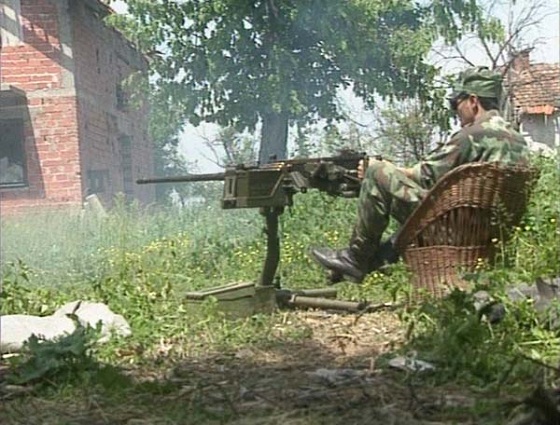Aernout Mik’s video Raw Footage, for which the artist compiled discarded bits of news footage from the Yugoslavian conflicts of the 1990s, has the natural spectacular appeal of images of war. Its firefights, shellings, and POW lineups – projected, unaltered and with the original sound, on two screens – are fascinating in themselves, and their exclusion from the nightly film reels makes us wonder about the news media’s criteria, and what it deems relevant. Why was the beach-house machine-gunner above not fit for broadcast? Was he too casual or too brutal, or was he simply unfortunate enough to be filmed on a busy news day?
He would not suffer such exclusion today. The smartphone camera panopticon, along with emerging, concerted efforts by agencies such as Reuters to put their near-raw film online, has shifted the burden of curation from a few network television editors to a distributed base of potential viewers and sharers. In 2011, a mere five years after its creation, Raw Footage may be obsolete; the authoritative division between what is and is not shown on television has melted away, and news editors follow internet video trends more often than they create them.
Another work from the Yugoslavian conflict, Vuk Cosic’s War in Yu (1999), shows what most of us already know – that this shift is not merely cultural but physical, and that our distributed content-curation relies on a distributed infrastructure. Cosic compiled visualizations of Yugoslav internet routing data recorded over the course of a NATO bombing campaign between May 1st and May 10th, 1999, then displayed the daily images in a looping animated GIF. It is impossible to know for certain what happens to nodes when they disappear; in at least some cases, they have been physically destroyed by the bombardment. Despite this destruction, the internet carries on – new nodes appear to pick up the slack, instantly falling into place in exactly the manner DARPA hoped when first developing the internet as a system that could survive nuclear war.
War in Yu might be my favorite GIF. Its clean lines both perfectly reflect and perfectly conceal the grisly reality on the ground, depicting the war with the inhumanity of the systems it is transmitted upon. The internet suddenly appears shockingly dispassionate, if such a thing can be said of a computer network at all; there is a pang of doubt and fear when we abstract so far from the humanity of culture and socialization that dominates our idea of the internet. The more familiar the internet seems, the more it loses its technological wonder, the better Cosic’s work becomes.
A U.S. soldier is dancing oldschool on a M1068/TANK while MLRS rockets are flying behind him is a welcome relief from the fear of War in Yu, and shows well the sort of video that might never have come to light in an age of network news editors. It’s fun. It’s a side of war that could never be televised, because it’s lighthearted and nobody dies. Still, though, something is cut out; we never know where the rockets land. It’s good to see the humanity in war, but that story requires omission, too.
Business/Pleasure is Will Brand's new daily column of the best of Video Art and YouTube crap. Most days have one business video and one pleasure video. Got a tip? E-mail it to will.brand@gmail.com.




Comments on this entry are closed.